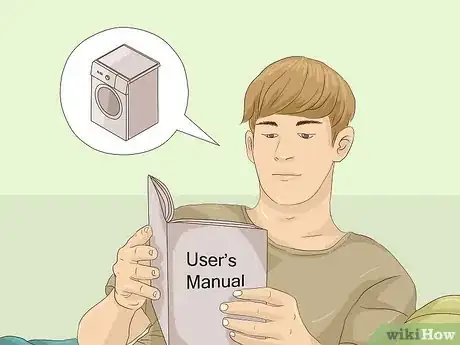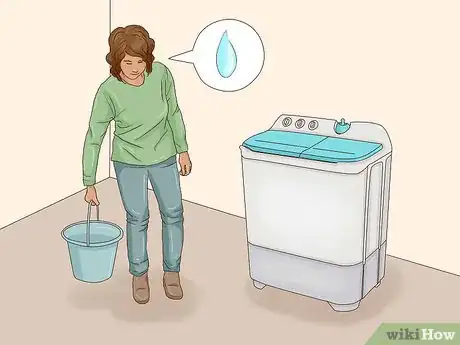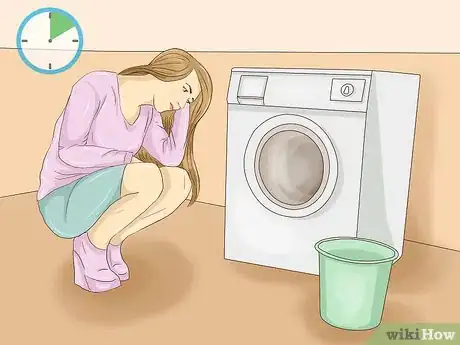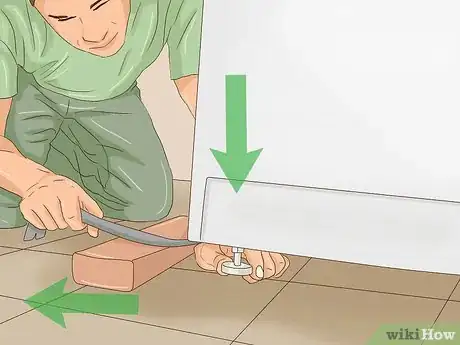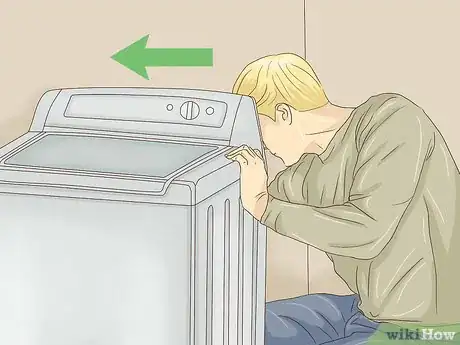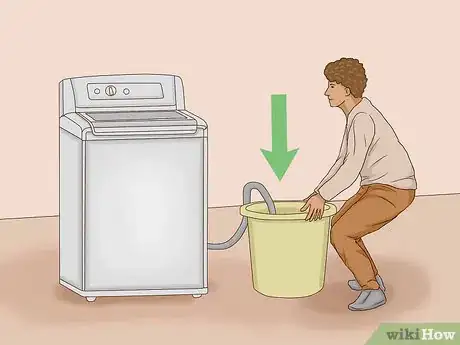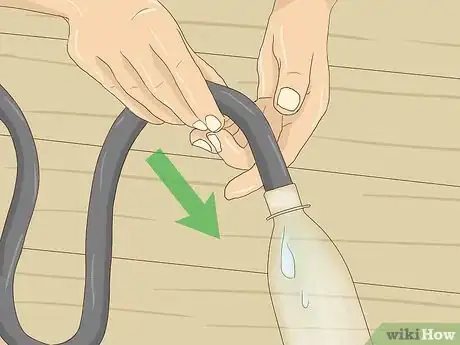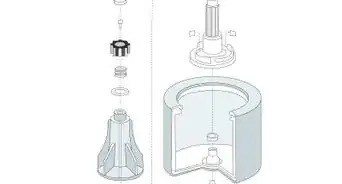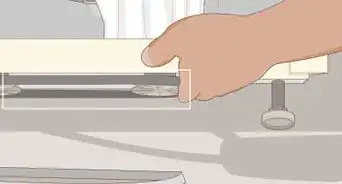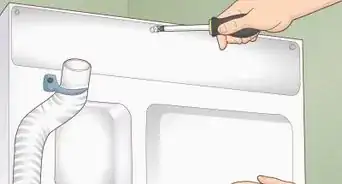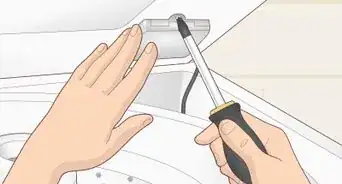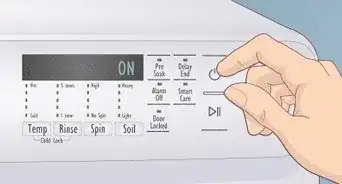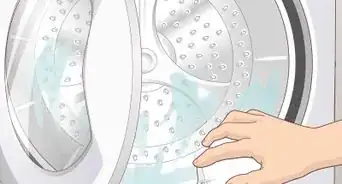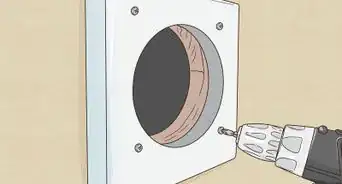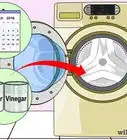This article was co-authored by Gevorg Grigorian. Gevorg Grigorian is an Appliance Repair Specialist and the Owner of G and R Appliance Repair in Los Angeles, California. With over 12 years of experience, Gevorg specializes in residential and commercial appliance repairs as well as heating, ventilation, and air conditioning (HVAC) services. Gevorg holds a BS in Business Administration and Management from California State University-Northridge.
This article has been viewed 431,630 times.
If your machine isn’t draining properly, you’ll have to drain it yourself before attempting to repair it. Before doing that, you want to plan out exactly what you’re doing to avoid injury and massive spills. If you have a front-loading machine, you need to drain the water from a filter located along the bottom of its front end. If your machine is top-loading, you can unhook the drain hose in back and fill a bucket with that.
Steps
Creating a Safe Environment
-
1Read the manual for your washer. The methods included here are fairly standard and should generally work with most washers. Even so, break out your owner’s manual and read over the appropriate sections, just in case any directions or advice are particular to that manufacturer and/or model. Check its table of contents or index for subjects like:
- Drainage issues and troubleshooting
- Disconnecting and reconnecting drain hoses and/or filters
-
2Avoid electrical shock. Draining your washer shouldn’t be an out-of-control project with water flying everywhere, but play it safe anyway. If your washer is plugged into a power outlet, unplug it. If it’s hardwired into your electrical system instead, switch off the appropriate circuit breaker. Eliminate the risk of electrocution just in case you experience any unforeseen mishaps.[1]
- Do the same with any other electrical devices in the immediate area.
Advertisement -
3Grab some towels. Again, this project shouldn’t create a huge mess, but be prepared for at least a little water to possibly go wild. Before you begin, set yourself up with some towels to keep on hand. Make clean-up a cinch by having them within easy reach in case you spill any water on the floor or elsewhere.[2]
- Draining a front-loading machine is more likely to be messy than a top-loading machine, so if that’s what you have, expect more spills.
- In addition to towels, you could also lay out a tarp, dropcloth, or similar material on the floor around your washer.
-
4Figure out where to put the water. This may seem like a no-brainer, but make life easier by knowing exactly how you’ll dispose of the water before you start. If your laundry room has a drain in the floor, use that. If your washer is in a bathroom and has a drainage hose that will reach, use your bathtub or shower stall. Otherwise, have a bucket or dish ready to transport the water to a sink or tub elsewhere in your home.[3]
- Be aware that used water from your washer is usually considered “gray water.” Your local, state, or even federal government may have laws regarding the proper disposal of gray water. This means that you may not be allowed to simply toss it outside so it can soak into the ground.
- If you need to use a bucket or dish, consider the area that you need to cross between the washer and the drain that you choose. You may want to protect surfaces or clear the area of anything easily damaged by water in case any spills out along the way.
-
5Wait for the water to cool. If you only used cold water for your last load, go ahead and skip this step. If, however, you used hot water, give it time to cool off before you attempt draining. Don’t make things worse by scalding yourself.[4]
- This is especially important with front-loading machines. With these, you can’t open the door and test the water, and your hands will definitely get wet once you start draining.
- The time it takes for the water to cool off to a safe temperature will vary by your settings and your machine. As a precaution, wear safety gloves when you start your project.
Draining a Front-Loading Machine
-
1Locate the drainage filter. Look along the bottom of the front of your machine. Find the small panel that covers the drainage filter. Most panels these days are hinged and can be easily removed without tools, but if your panel is screwed into place, find an appropriate screwdriver.
- Don’t remove the panel just yet. For now, just note its location.
- This is usually on the left or right side along the front of the washer.
-
2Raise the front of the machine, if it’s safe to do so. Note that the drainage filter is along the very bottom of your machine, which means you’re going to have to use a very shallow dish to catch water coming out of it. To make life easier, pull the machine away from the wall just enough for you to tip it back a little. Lift the front end a few inches off the floor. Slide bricks or solid blocks of wood underneath the front corners for them to rest on while you work so you can use a deeper dish.
- The washer weighs a lot on its own, and the water inside makes it even heavier. If possible, have a partner help you with this step to make it easier.
- Do not attempt lifting your machine if you don't think you're able to do so, even with a partner. Skipping this step just means more trips to and from your drain. This may be a pain figuratively speaking, but it’s better than injuring yourself for real.
-
3Remove the panel and set up your gear. Unscrew or unhinge the panel to your drainage filter. Lay a towel over the floor directly underneath. Then, depending on your machine’s design:
- Set a shallow bowl, dish, or similar container directly below the filter if no funnel or similar device is included behind the panel.[5]
- If there is a funnel or similar device to carry water away from the machine, extend it and set your dish below that.
-
4Unscrew, drain, and repeat. Once your towel and dish is in place, start unscrewing the drainage filter very slowly. Once it opens just enough for water to start trickling out in a manageable stream, stop unscrewing. Let the dish fill close to capacity, then screw the filter shut again. Dispose of the drained water, then repeat until no more water empties out of your machine.
- Don’t unscrew the filter all the way. This will enable more water than your dish can hold to spill out of the machine all at once. It will also make it difficult for you to fit the filter back into place and seal it shut as water continues to empty out.
- Turn the filter counterclockwise to unscrew it.
-
5Lower your machine and finish draining. If you propped the front of your machine up on bricks, keep in mind that there is still some water inside, even though it has quit draining. Make sure the filter is sealed tight, then remove the bricks and set the machine back on the floor. Now finish draining your machine as you did before, using a shallower dish if necessary.[6]
- Tipping your machine backward and propping the front up on bricks causes the water inside to gravitate toward the back.
Emptying a Top-Loading Machine
-
1Pull your machine out from the wall. If you’re worried about scratching up your floor, lift the front end of your machine so a partner can lay a dropcloth, blanket, or similar material underneath. Then do the same with the back, if possible. Once you’re ready, slowly pull the machine away from the wall. Stop once you’re able to reach the drain hose in back. Don’t pull it out so far that you end up yanking any hoses out of the wall.[7]
- If the machine’s too heavy for you to move, open the lid. Use a pitcher or similar container to ladle water out into your bucket. Empty as much water as you like this way, or just until the machine’s light enough for you to move.
- If you’re working by yourself and the machine’s still too heavy even after you’ve ladled out as much water as you can, ask a partner to help you.
-
2Detach the drain hose from the wall. Uncouple the drain hose where it meets the drainage pipe inside your wall. Be careful to keep that end of the hose raised higher than the machine itself as you do. Expect gravity to start pumping water out of the hose before you’re ready if you lower it.[8]
- You’ll need to do this even if you ladled all the water out of the machine’s inner drum. There is still water underneath that, which you can’t reach through the top of the machine.[9]
-
3Fill your bucket. Avoid spills by feeding the hose’s open end inside the bucket before setting the bucket on the floor. As the hose lowers, water will start pumping out on its own, so keep an eye on the bucket’s water level as it rises. Once it fills as much as you’d like, simply raise the hose’s open end above the machine to stop the flow. Drain the bucket and repeat until no more water comes out.[10]
- Although it may be tempting to use the largest bucket possible and fill it all the way up, remember the distance you have to carry it. Only empty as much at a time that you can safely carry without sloshing any over the sides.
- Alternately, you can simply aim the hose’s open end over a floor drain or into a bathtub if there’s one within its reach.
-
4Finish draining the last of the water into a bottle. To completely drain your machine, lower the hose to floor level. The rim of your bucket or bathtub is probably too high for this, so switch to a gallon-size jug or bottle. Lay it on its side and cover its mouth with the hose’s open end. Drain the bottle as it fills up, and repeat until the job is done.[11]
- If the hose’s open end is larger than the bottle’s mouth, try using a funnel to reduce spills.
Community Q&A
-
QuestionWhat do I do if my washer doesn't drain the water by itself?
 Community AnswerCall a repairman, most likely the pump has stopped working. Or, drain it yourself, and buy a replacement pump online.
Community AnswerCall a repairman, most likely the pump has stopped working. Or, drain it yourself, and buy a replacement pump online. -
QuestionWhat can I do if the machine has stopped and the fuse is blown?
 Community AnswerSimply take the plug out of the socket and take the old fuse out of the plug, then replace with the new one.
Community AnswerSimply take the plug out of the socket and take the old fuse out of the plug, then replace with the new one. -
QuestionDo I need to drain my machine after every wash?
 PBradleyCommunity AnswerYes. Your machine will most likely start filling it again with the next load, which will cause it to overflow if you do not drain it between washes.
PBradleyCommunity AnswerYes. Your machine will most likely start filling it again with the next load, which will cause it to overflow if you do not drain it between washes.
Things You’ll Need
All Methods
- Owner’s manual
- Towels and/or similar materials
- Safety gloves (if the last load used hot water)
Front-Loading Machines
- Screwdriver (for some models)
- Shallow dish or bowl
- 2 bricks or similar materials (optional)
Top-Loading Machines
- Bucket
- Gallon-size bottle
- Pitcher or similar container (optional)
References
- ↑ http://removeandreplace.com/2015/09/30/how-to-drain-the-water-out-of-a-washing-machine-top-load-front-load/
- ↑ http://removeandreplace.com/2015/09/30/how-to-drain-the-water-out-of-a-washing-machine-top-load-front-load/
- ↑ http://removeandreplace.com/2015/09/30/how-to-drain-the-water-out-of-a-washing-machine-top-load-front-load/
- ↑ https://www.whitegoodshelp.co.uk/washing-machine-wont-drain-water/
- ↑ http://removeandreplace.com/2015/09/30/how-to-drain-the-water-out-of-a-washing-machine-top-load-front-load/
- ↑ http://removeandreplace.com/2015/09/30/how-to-drain-the-water-out-of-a-washing-machine-top-load-front-load/
- ↑ http://removeandreplace.com/2015/09/30/how-to-drain-the-water-out-of-a-washing-machine-top-load-front-load/
- ↑ http://removeandreplace.com/2015/09/30/how-to-drain-the-water-out-of-a-washing-machine-top-load-front-load/
- ↑ https://www.whitegoodshelp.co.uk/washing-machine-wont-drain-water/
About This Article
To drain a front-loading washing machine by hand, you’ll need some old towels and something to drain the water into, like a deep baking tray or dish. Before you start draining your washer, make sure it's unplugged or turned off at the wall to avoid an electric shock. Then, lay the towels down in front of the washer and position your dish underneath its drainage filter. This should be at the bottom of the washer’s front side and may be covered with a panel. Unscrew the drainage filter slowly until it starts to leak water. You may need to close the filter and empty the dish a couple of times until the water stops. Draining a top-loading washing machine is a little easier. Just pull it away from the wall, detach the drain hose from the wall, and aim it into a bucket. Let the water drain until it stops. For more tips, including how to drain a washing machine directly into a bathtub or shower stall with a drainage hose, read on!
